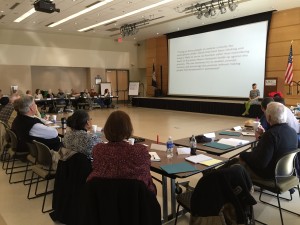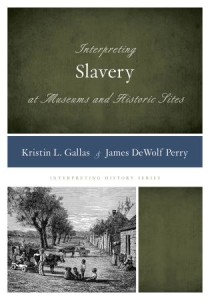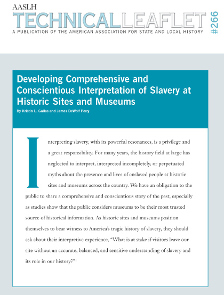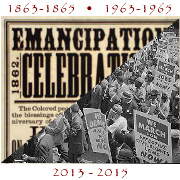Best Practices in Slavery Interpretation is a Tracing Center project to research, evaluate, and disseminate, via writing and training, best practices for interpreting the history of slavery at museums and historic sites.
Results of this project to date include:
- Kristin L. Gallas and James DeWolf Perry, “Developing Comprehensive and Conscientious Interpretation of Slavery at Historic Sites and Museums,” a “technical leaflet” published by the American Association for State and Local History in spring 2014
- Kristin L. Gallas and James DeWolf Perry, editors, Interpreting Slavery at Museums and Historic Sites (Rowman & Littlefield, January 2015)
 Kristin L. Gallas and James DeWolf Perry, “Developing Comprehensive and Conscientious Interpretation of Slavery at Historic Sites and Museums,” in Max van Balgooy, ed., Interpreting African American History and Culture at Museums and Historic Sites (Rowman & Littlefield, December 2014)
Kristin L. Gallas and James DeWolf Perry, “Developing Comprehensive and Conscientious Interpretation of Slavery at Historic Sites and Museums,” in Max van Balgooy, ed., Interpreting African American History and Culture at Museums and Historic Sites (Rowman & Littlefield, December 2014)- Professional workshops and public programs offered by the Tracing Center for historic sites and museums
We maintain an online resource page for readers of the book and the technical leaflet here.
The “Best Practices in Slavery Interpretation” project
“The lack of talk about an unresolved subject, in this case slavery, suggests its power and pain, and suggests that concerted social forgetting has become an organizing principle.” ((Jennifer L. Eichstedt and Stephen Small, Representations of Slavery: Race and Ideology in Southern Plantation Museums (Washington, D.C.: Smithsonian Books, 2002), p. 1.))
 The interpretation of slavery at historic sites and museums has long been a charged issue. The subject is clearly controversial, emotional, and even political at times, and the preoccupation with the emotional comfort of visitors profoundly shapes how the staff deliver interpretation. ((Amy M. Tyson. “Crafting emotional comfort…” Museum and Society 6(3), 247.)) Yet the public is often more able to hear and absorb the painful history of slavery than they are given credit for. Experience and research demonstrate this disquietude cuts in multiple ways: sometimes staff and boards say they are not nervous, but concerned that visitors are not ready for the material. Others argue that these responses mask the real anxieties of museum professionals themselves. Some admit these anxieties directly. In her study of how public historians make sense of difficult topics, Dr. Julia Rose determined that learners “must work through the internal conflict in an emotional and cognitive process to make sense of the new difficult knowledge.” ((Julia Rose, “Interpreting Difficult Knowledge,” History News 66(3), Technical Leaflet.))
The interpretation of slavery at historic sites and museums has long been a charged issue. The subject is clearly controversial, emotional, and even political at times, and the preoccupation with the emotional comfort of visitors profoundly shapes how the staff deliver interpretation. ((Amy M. Tyson. “Crafting emotional comfort…” Museum and Society 6(3), 247.)) Yet the public is often more able to hear and absorb the painful history of slavery than they are given credit for. Experience and research demonstrate this disquietude cuts in multiple ways: sometimes staff and boards say they are not nervous, but concerned that visitors are not ready for the material. Others argue that these responses mask the real anxieties of museum professionals themselves. Some admit these anxieties directly. In her study of how public historians make sense of difficult topics, Dr. Julia Rose determined that learners “must work through the internal conflict in an emotional and cognitive process to make sense of the new difficult knowledge.” ((Julia Rose, “Interpreting Difficult Knowledge,” History News 66(3), Technical Leaflet.))
What does it mean to tell a “comprehensive and conscientious” story about slavery and how do you know if you’re doing it? The answer is: research, training, evaluation. Historic sites and museums of all sizes have launched research initiatives to uncover the lives of enslaved people, details about their interactions with each other and the white people with whom they engaged. Once the research is at hand, staff must undertake the critical two-step process of developing an interpretive plan and training their staff to deliver it. In addition to traditional topics like presentation style and content, training to interpret slavery involves engaging staff in critical discussions about race and identity, as these emotionally charged issues are often at the root of why people are uncomfortable talking about slavery. Equipping staff with the tools to work through their emotions around race and slavery, and to help visitors with the same, will improve understanding and communication about this sensitive topic. It is also a matter of skill-building and practice.
 It’s also important for sites/museums to understand their visitor’s perspectives. Fully 90% of Monticello visitors indicate strong agreement with the statement, “I believe it is important to explore history completely, including subjects that are uncomfortable to discuss and that people may disagree about.” “I strongly believe that if we learn about history perhaps we as a society can make better decisions about our future,” remarked one respondent. ((Monticello visitor survey, fall 2011, via Linnea Grim, director of education at Monticello.)) By learning about visitor expectations and “baggage,” sites/museums can stop making assumptions about what visitors want and deliver a more inclusive story to their visitors. There is proof that as museums and historic sites present an accurate, inclusive slavery interpretation, they draw more diverse visitors and enlighten those who already visit. ((Deborah Huso. “Beyond Moonlight and Magnolias: The New Interpretation of Plantation Society.” Legacy 17(1), pp. 19-23.)) When sites are sensitive to how they frame racial dynamics, they are helping to create healthier communities for our multicultural society of the 21st century. As more and more sites begin to embrace their role not only as interpreters but as providers of space for conversation and conveners in their communities, this project builds capacity to facilitate the dialogue that is an essential means of making sense of the painful histories and legacies of slavery.
It’s also important for sites/museums to understand their visitor’s perspectives. Fully 90% of Monticello visitors indicate strong agreement with the statement, “I believe it is important to explore history completely, including subjects that are uncomfortable to discuss and that people may disagree about.” “I strongly believe that if we learn about history perhaps we as a society can make better decisions about our future,” remarked one respondent. ((Monticello visitor survey, fall 2011, via Linnea Grim, director of education at Monticello.)) By learning about visitor expectations and “baggage,” sites/museums can stop making assumptions about what visitors want and deliver a more inclusive story to their visitors. There is proof that as museums and historic sites present an accurate, inclusive slavery interpretation, they draw more diverse visitors and enlighten those who already visit. ((Deborah Huso. “Beyond Moonlight and Magnolias: The New Interpretation of Plantation Society.” Legacy 17(1), pp. 19-23.)) When sites are sensitive to how they frame racial dynamics, they are helping to create healthier communities for our multicultural society of the 21st century. As more and more sites begin to embrace their role not only as interpreters but as providers of space for conversation and conveners in their communities, this project builds capacity to facilitate the dialogue that is an essential means of making sense of the painful histories and legacies of slavery.
While a good number of historic sites and museums have undertaken initiatives to create a more conscientious and comprehensive interpretation of slavery, there has been no field-wide standard for best practices in this area. To that end, the Tracing Center’s Best Practices in Slavery Interpretation is a ground-breaking project to research, evaluate, and disseminate, via writing and training, best practices for interpreting the history of slavery at museums and historic sites. “When future generations hear these songs of pain and progress and struggle and sacrifice, I hope they will not think of them as somehow separate from the larger American story. I want them to see it as central – an important part of our shared story.” ((Remarks by President Barack Obama at the groundbreaking ceremony of the National Museum of African American History and Culture, February 22, 2012.))


